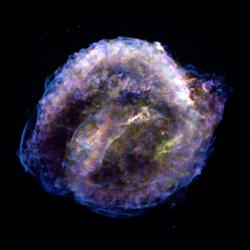 NASA’s Chandra X-Ray Observatory has created this amazing image of one of the youngest supernova remnants in the galaxy. The supernova that created it blazed in the sky more than 400 years ago, before the telescope had even been invented. No problem, though, it was bright enough that you didn’t need a telescope – it reached the brightness of Jupiter at its peak. And one of the greatest astronomers in history, Johannes Kepler was there to see it.
NASA’s Chandra X-Ray Observatory has created this amazing image of one of the youngest supernova remnants in the galaxy. The supernova that created it blazed in the sky more than 400 years ago, before the telescope had even been invented. No problem, though, it was bright enough that you didn’t need a telescope – it reached the brightness of Jupiter at its peak. And one of the greatest astronomers in history, Johannes Kepler was there to see it.
Now 400 years, the Chandra X-Ray Observatory has turned back to image Kepler’s Supernova Remnant, and this is what it saw. The photograph was made by combining more than 9 days of Chandra observing time into a single X-ray image.
Before these observations, the object was a bit of a mystery. There seem to be large quantities of iron, and no detectable neutron star – that would indicate a Type Ia supernova, where a white dwarf explodes after consuming a certain amount of material from a companion star.
But optical light showed that the object is expanding into a cloud of dense material rich in nitrogen. That would indicate that it was a Type II supernova, where a single massive star sloughs off layers of material before detonating.
The new observations from Chandra helped solve the mystery. Astronomers calculated the relative amounts of oxygen and iron in the debris cloud, and determined that it resulted from a Type Ia supernova. It might also be a rare variety of prompt Type Ia explosions, which detonate in only 100 million years, and not billions of years after they form as white dwarfs.
